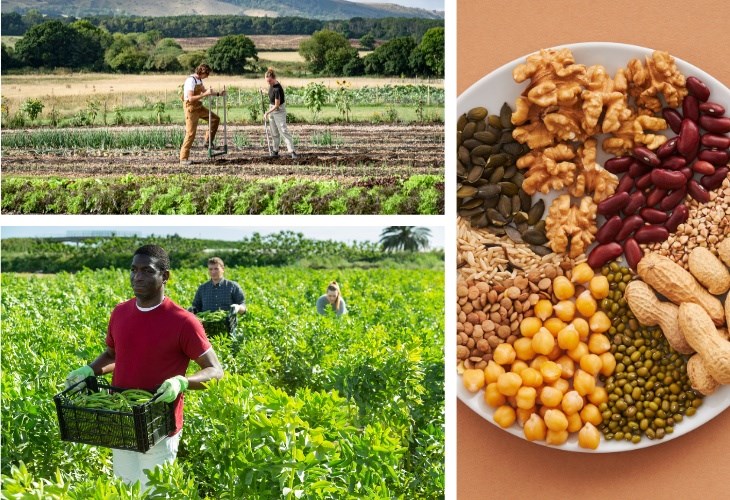Food Policy: U.S. must reduce meat consumption by 82%
New research concludes that the U.S. must reduce meat and poultry consumption by 82% to operate within planetary health boundaries.
The United States' astronomical meat and poultry consumption is impacting the climate and ecosystems worldwide. Thousands of acres of the Amazon rainforest, the lungs of the Earth, have been destroyed to grow soy feed for U.S. chickens and cattle. Cattle and farmed animal manure are some of the top emitters of methane and nitrous oxide, two extremely potent greenhouse gases fueling heat waves and increasing wildfire frequency. Densely packed poultry barns have given rise to highly pathogenic avian influenza, which has killed untold numbers of wild birds worldwide, including critically endangered species such as the California condor. As one of the highest meat-consuming nations, our diets are having a disproportionate impact on the rest of the world. Emerging research calls for the U.S. to set ambitious meat reduction targets to shift toward a sustainable food system.
Key Facts:
- The U.S. is the number one meat-consuming nation per capita in the world, eating over half a pound of meat per person every day.
- In total weight, the U.S. consumes fourteen times more meat than Australia and almost twice the amount of meat as the entire African continent.
- If the entire human population adopted the same diets as the G20 nations by 2050, we would exceed the planet's limits for food-related greenhouse gas emissions by 263%. Worldwide adoption of the American diet would require over five Earths to support.
- In 2019, diets high in processed meat were responsible for 304,000 deaths and diets high in red meat were responsible for 896,000 deaths globally.
- Animal farming already uses over three-quarters of the planet's agricultural land. If we continue at the current rate of meat and dairy consumption per person, the amount of cropland needed will increase by 67% by 2050. That's about the size of Brazil.
- Producing enough nutritious food within planetary boundaries for an estimated 10 billion people by 2050 will only be possible with a significant reduction in animal-sourced foods in the G20 countries and a global increase in plant-based foods in our diets.

What are planetary health boundaries?
The planet's land, water, and soil nutrients are finite. Furthermore, if greenhouse gas emissions and biodiversity loss are left unchecked, they can reach a tipping point, causing catastrophic effects on global civilization and on the planet. Scientists have identified six key earth processes and factors—climate change, nitrogen cycling, phosphorus cycling, water, biodiversity, and land use—that must stay within certain boundaries for a healthy, sustainable planet. Our food system's greenhouse gas emissions, nitrogen and phosphorus use, water irrigation, cropland use, and extinction caused by habitat loss and pesticides all threaten to knock these factors out of balance.
In 2019, a team of 37 scientists from across disciplines known as the EAT-Lancet Commission developed global dietary guidelines that optimize both human health and environmental sustainability. The report concluded that globally, increasing the consumption of vegetables, fruits, whole grains, legumes, and nuts and decreasing red meat, sugar, and refined grain consumption would provide major health benefits and increase the likelihood of achieving the United Nation's Sustainable Development Goals and staying below 2°C global warming.
The United States is Dangerously Off Track
However, human diets vary greatly from region to region and from country to country. As a result, the dietary shifts needed to sustain public health and restore our planet are different among nations.
In May 2023, CIWF released a groundbreaking report analyzing the current food consumption patterns by country and how they compare to the EAT-Lancet diet optimized for human and environmental health. As the top meat-consuming country in the world, the United States must reduce its total meat and poultry consumption by 82% to meet the EAT-Lancet's planetary health guideline. This is the first science-based national reduction target that can be incorporated into local, state, and federal government policy.

Roadmap to 82% Reduction by 2050
Despite the significant role that meat and poultry production play in the climate, biodiversity, and public health crises, little concern has been given to food in government policy. Just as many governments have committed to reducing fossil fuels and transitioning to clean energy, U.S. policymakers must commit to reducing meat and transitioning to plant-forward diets if we are to realistically stay below 2°C (3.6°F) global warming and within planetary health boundaries. Thankfully, many of the levers and solutions to meat overconsumption are already available. However, multiple interventions will need to be implemented simultaneously to achieve this target. CIWF has identified 13 key interventions the U.S. government and other stakeholders can leverage to achieve this reduction target:

